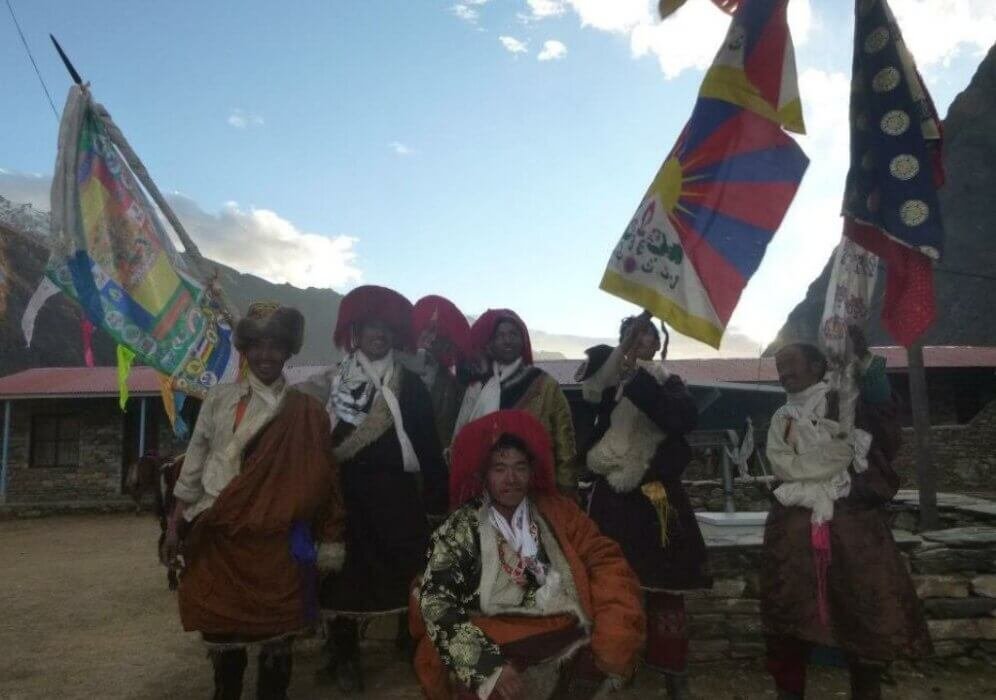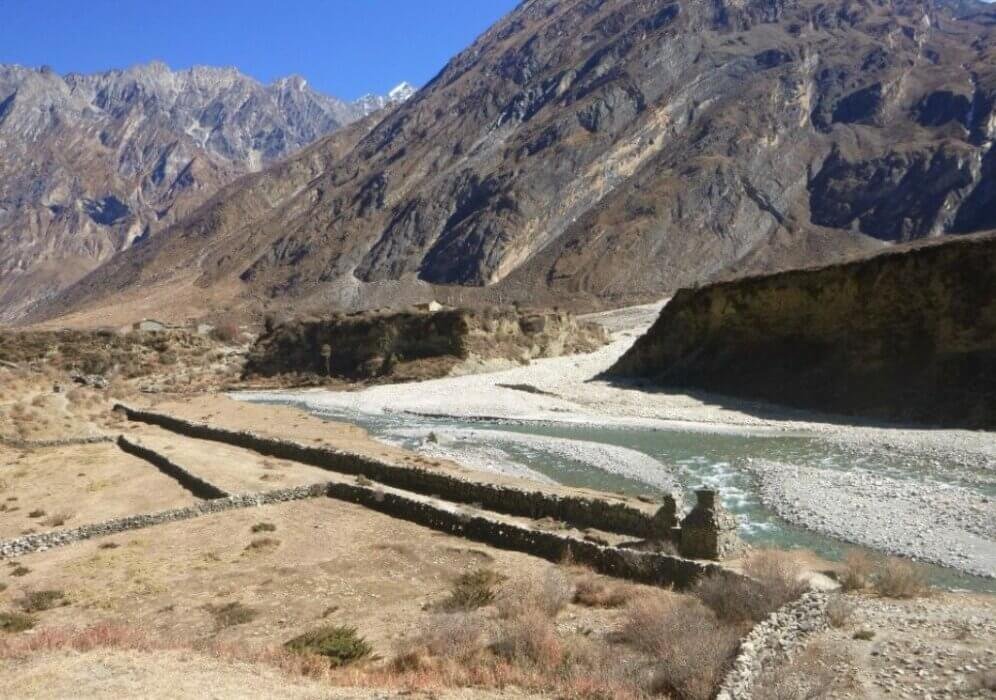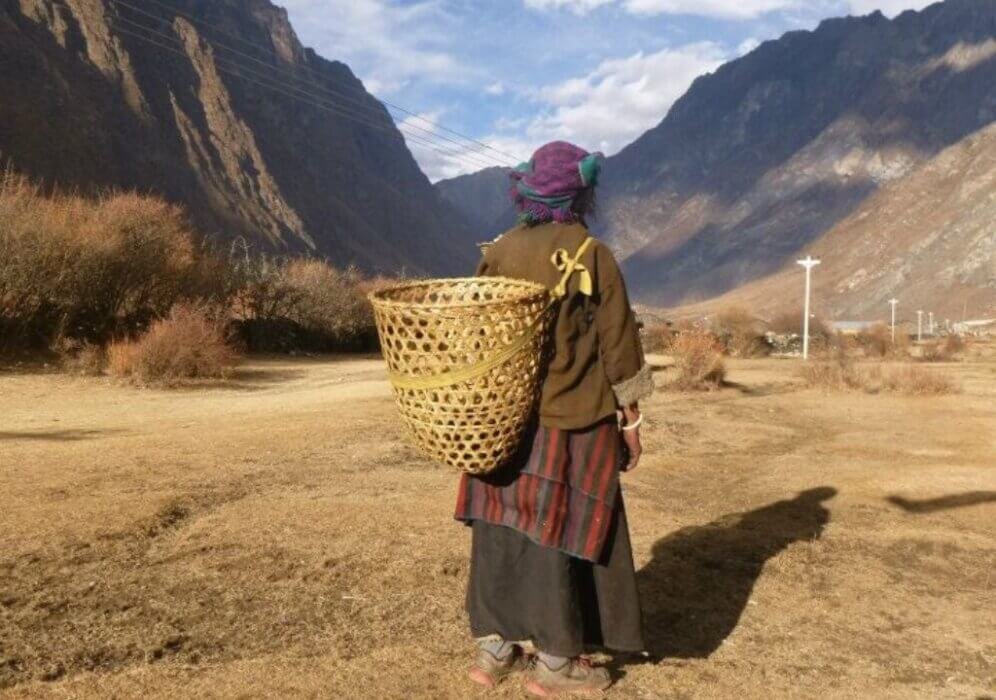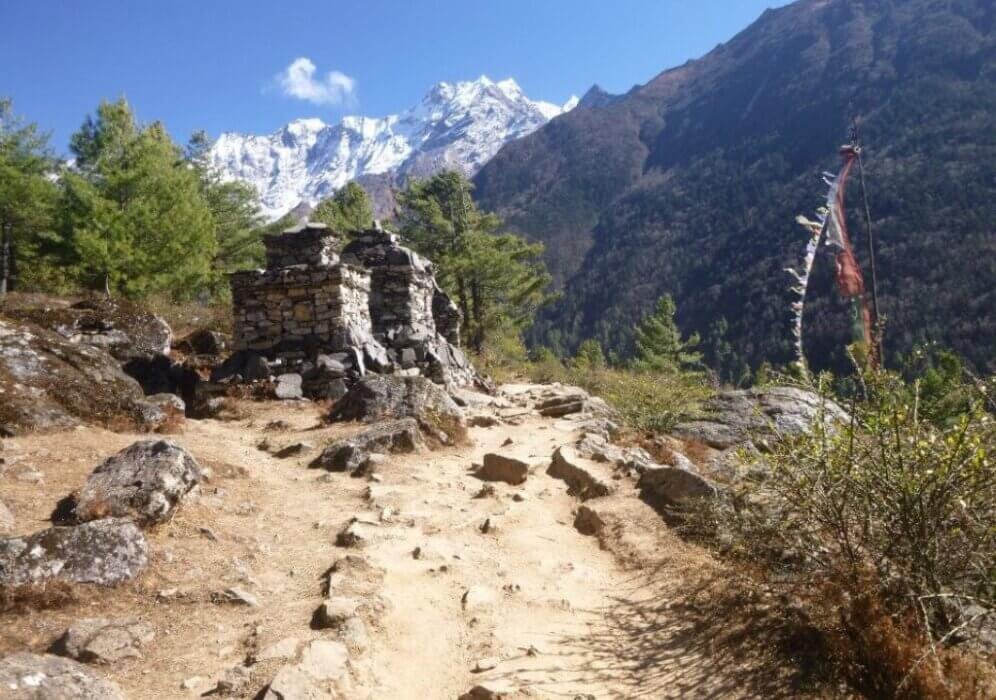Tsum Valley Trek - 13 Days

-
Duration:
13 days -
Max Altitude:
3700m -
Difficulty Level:
Medium -
Group Size:
1- 15 People -
Destination:
Mu Gompa -
Accommodation:
Hotel/Lodges -
Transportation:
Bus, Car, Jeep or Van -
Trekking Season:
March to May and September to December
Trip Overview
The Tsum Valley Trek is not just a simple trek but a journey that retains the memories of walking through nature, enjoying Himalayan landscapes, and a spiritual heritage. Located in the northern Gorkha district, 13 Days Tsum Valley Trek involves adventure through lush forests and age-old traditional settlements with lush terraced fields featured together within the backdrop of the majestic peaks of Himalaya.
Trekking in the Tsum Valley also gives breathtaking views of nature and the most unique cultural experience for tourists. The place is popularly known for its scenery, waterfalls, blooming wildflowers, and towering mountains such as Manaslu, Shringi Himal, and more. As you trek along the Budi Gandaki River en route to Tsum Valley, you come past several Buddhist monasteries, giving insights into the rich traditions of the region.
Tsum Valley is a must-visit destination for those who are looking forward to enjoying the Himalayan beauty and local culture and traditions. You can also combine Manaslu Circuit with Tsum Valley Trek in this region.
Preparation for Tsum Valley Trek
Required Permits for 13 Days Tsum Valley Trek
When trekking into Manaslu Region, you’ll need to get various Permits. We have listed here below the permits required:
Restricted Area Permit for Tsum Valley
The government of Nepal defines Tsum Valley as a restricted area to maintain border security. As a result, trekkers must obtain a Restricted Area Permit (RAP) to enter the region.
The RAP permits the trekker to visit specific areas such as the lower Gorkha and Tsum Valley, which include Sirdibas, Lokpa, Chumling, Chekampar, Nile, Chule, and some parts of Chumnubri Rural Municipality (wards 3, 6, and 7). Then, all must have the permit shown at the Jagat entry point before heading into the region.
The RAP is available from a government-registered and licensed trekking agency, which will apply on behalf of trekkers. The cost of applying for the permit varies depending on the season of travel and duration of trekking within the restricted area.
From September to November (Autumn), the fee is $40 for the first week and $7 for each additional day. The other period from December to August (Winter, Spring, and Summer) would cost about $30 for the first week and $7 for each extra day (as per the July 2022 rates set by Nepal’s Department of Immigration).
Manaslu Conservation Area Project Permit
Another permit required for the 13 Days Tsum Valley Trek is the Manaslu Conservation Area Project (MCAP) permit. The authorities use the fees charged for the permit to protect and sustainably develop this conservation area, focusing on preserving its biodiversity and natural beauty.
The cost of the permit varies depending on the nationality. The fee for the nationals of SAARC countries is NPR 1,000 (around $10), and for the rest of the nationals, NPR 3,000 (almost $30).
Tsum Valley Restricted Area Permit
The Tsum Valley Restricted Area Permit is a must for trekkers about to go on the Tsum Valley Trek. The entry fee of this permit varies based on the season: USD 40 per person from September to November for the first eight days and USD 7 per person for each additional day.
For the rest of the year, the fee will be reduced to USD 30 for the first seven days and USD 5 for each additional day from December to August, while this permits access to Tsum Valley itself, which boasts untouched, pristine nature and its unique cultural traditions.
Guides and Porters
Trekking in Tsum Valley becomes easier with the presence of a certified guide. In fact, guides are mandatory while taking on this trek since this trek features ruggedness and remoteness around the Manaslu region. Most trails within such restricted zones will be unmarked and hard to navigate unless you have someone well-trained and familiar with that terrain.
Guides are the key helpers for your easy navigation during the trek. Besides navigation and cultural sharing, they are also trained in handling emergencies like altitude sickness or sudden weather changes, ensuring safety all through the trek. Last but not least, a visitor is legally mandated to hire a registered guide within this restricted area.
Porters also play a huge role in making the 13 Days Tsum Valley Trek enjoyable. They help you carry the bulky and heavy loads of gear and equipment, while you will enjoy the surroundings. The journey becomes more comfortable to travel with such contributions, thus allowing full appreciation for the beauty and the tranquility of the Tsum Valley.
Best Time To Go For 13 Days Tsum Valley Trek
Spring Season
Spring, undoubtedly, is one of the very best times for the Tsum Valley Trek. Weather remains mild, with clear skies and excellent daytime temperatures for trekking. The surroundings are lively by flowering rhododendrons that create spectacular splashes of color in this region. Trekkers will be able to see snow-covered points this season, thick, lush forests, as well as some of the localities indicative of and strongly influenced by traditional Tibetan culture. Devoted to nature, spring allows visitors to witness the absolute wake-up of nature in this beautiful Himalayan region; however, trails get a bit busy in this season.
Autumn Season
Autumn is also an excellent time for trekking in the Tsum Valley. The views from the many post-monsoon skies give beautiful visibility; hence, the scenery becomes lively than other seasons. The forests also turn from green to bright gold and amber, thus offering wonderful contrasts to the peaks. This season also coincides with numerous local festivals; thus, trekkers will get some unique culture along their adventure. Cool, comfortable trekking weather, especially at high elevations, but just like spring, it is a peak season when early booking is advisable to get accommodation and permits.
You can go through our Short Manaslu Circuit Trek of 8 Days and Manaslu Circuit with Tsum Valley Trek packages and plan for your next treks in Nepal with Mountain Treks Nepal.
Communication and Internet during the Tsum Valley Trek
There are very limited telecommunication facilities in the remote region of the Tsum Valley Trek, making it quite hard to stay in touch. Most of the places have partial cellular coverage, which is pretty unreliable, especially when going up the elevations. For the Internet, several tea houses have Wi-Fi, but the speed can be quite slow and usually requires an additional charge. Trekkers should use satellite phones or prepaid SIM cards with NTC or Ncell for necessary connections.
Currency Exchange and ATM
Trails around the Tsum Valley Trek have no facilities such as banks and ATMs, so it is essential to carry adequate cash. The only place where ATMs are accessible is Kathmandu or Pokhara. Exchange your currency in major cities before starting the trek. It makes sense to keep small changes as they are more practical in many tea houses and local shops. Big notes are rarely accepted or exchanged in these places.
Electricity and Drinking Water during the Tsum Valley Trek
The common source of electricity in the Tsum Valley is solar or hydropower in the teahouses. Still, it may not be available at all times, especially during cloudy weather or peak trekking seasons. Charging electronic devices usually incurs an extra charge. People obtain drinking water either from tea houses or natural streams. It can be purified for safe use with purification tablets or filters. Some trekkers prefer boiled water from tea houses, which usually will cost them. We advise you to carry a hot water bag or thermos to keep hot water handy. Temperatures in high altitudes can be freezing, especially during nighttime.
Travel Insurance
Travel insurance is most necessary for the trek to Tsum Valley because it offers unique challenges as high altitude travel. This trek pushes you up above 4,000 meters, where the effects of altitude sickness can become still more serious and may require immediate medical attention-or even helicopter evacuation. The Himalayan weather is highly unpredictable and can sometimes close the trail unexpectedly. This may also lead to flight cancellations or delays, affecting travel plans.
Comprehensive travel insurance protects trekkers from other unexpected happenings, such as loss of personal belongings and trip cancellations. It’s a must-have safety net for all trekkers within that rough and isolated terrain. You can buy travel insurance from companies like Travelex, WorldTrips, Allianz, MetLife etc.
Conclusion
The Tsum Valley Trek is one of Nepal’s hidden cultural gems, offering spectacular scenery. It provides a unique opportunity for soul-searching and immersing yourself in another culture, all in one trip. The sight of the magnificent Ganesh Himal, Sringi Himal and other high altitude peaks will greet you each time you head up the valley. En route, one is touched with the history of the Tsumba people and the Buddhist culture through their ancient monasteries and the ever peaceful path that is Buddhism.
13 Days Tsum Valley Trek is not only an adventure but also provides an insight into cultures that are thousands of years old and have never been exposed to today’s society. The landscapes untouched by modern civilization are truly magnificent. Whether it’s your first visit or your hundredth, the Tsum Valley is sure to leave you lost for words.
Trip Highlights
- Picturesque drive from Kathmandu to Machhikhola
- Fairly easy treks with less fear of altitude sickness
- Many Buddhist monasteries
- Lovely alpine, juniper and also rhododendron forests
- Explore around Tsum Valley
- Involve into the amazing unique culture, tradition of Nepalese influenced by Tibetan culture
- The glimpse of the majestic surrounding of various Himalayas
Trip Route

Have a Question? Inquire Now
Why Mountain Treks Nepal?
- Expert Team for Unparalleled Experience
- Best Price Guarantee
- Safety is the first Priority
- Easy Booking & Secure Online Payment
- Flexible And Personalized Service
- 24/7 Support
- Highest Satisfaction Guaranteed
- Highly Experienced Guides
- Your Satisfaction is Our Guarantee
- One-time Deposit, Assured for a Life Time
Detailed Itinerary
On the first day, you will be welcomed at Tribhuvan International Airport by a representative from Mountain Treks Nepal and transferred to your hotel. You will have a briefing with your trek coordinator on the adventure that is about to take place. Later, you can take your time to settle any other paperwork or permits.
In the evening, explore the resoundingly busy town of Thamel, known as the hub for shops, eateries, and trekking activity outlets. It’s a great time to really enjoy the food tastes of the vibrant capital city within as well, taste great local foods.
Today, we will begin our journey towards Mid-Western Nepal to start the Tsum Valley Trek. It takes about seven to 8 hours to reach the beautiful town of Machha Khola from Kathmandu. The drive takes you through the green hills and terraced fields. After an exciting but bumpy ride past Dhading Besi, you will finally reach Arughat. Crossing the Budhi Gandaki River with a bridge, we track along the western side of the Arughat. We start at a stone-paved path stretching past the local bazaar.
The drive then passes through Kuerepani and Soti Khola before reaching Machha Khola. During the trek, you will hike through terrace fields and forests as well as villages such as Armala and Lapubesi. The trail goes straight alongside the ever-flowing Budhi Gandaki River.
On the third day of the 13 Days Tsum Valley Trek, we will hike from Machha Khola to Jagat (1,400m). It is about a 6-7 hours long walk, after which we reach the entry point for the Tsum Valley. Kholar Besi, where you can have a dip in a natural hot spring, stays by the riverbank, where you can take a mild and relaxing bath.
Jagat is a wonderful village with stone-paved streets and traditional Gurung houses. The final part of the legal formalities are done here in order to enter the Manaslu Conservation Area.
This is a day when you will ascend to the beautiful village during your Tsum Valley Trek. This morning, we will enjoy a hearty breakfast in Jagat and afterwards take off for a trek to Lokpa. The duration of the travel is 5-6 hours; it is located at an altitude of 2240 m. As we pass through rocky ridges and the Gurung villages, the snow-capped Shringi Himal also brings more excitement to the journey.
Lokpa is the first village in Tsum Valley and is today considered a heaven of peace and beauty. Tonight ends your stay in a tea house.
This day involves a steep hike towards Chumling (2,385m). Rhododendrons feature the trail and provide the most beautiful mountain views, including Shringi Himal and Mount Manaslu. You will pass across rivers and gorges while crossing gompas, chortens, and barley fields as you hike uphill to reach Chumling.
Chumling represents the lowermost Tsum Valley. There are traditional stone houses in the village, which sit in a calm environment. You can visit local monasteries and learn about the Buddhist heritage of the region.
You will begin the day by crossing the Siyar Khola on a suspension bridge and then trekking through beautiful green forests of pine and rhododendrons. After hours of a steep climb, you will come across Chokhangparo (3,031m), one of the most picturesque villages from where you can see the majestic Ganesh Himal as well as the Boudha Himal ranges.
There are traditional stone houses and terraced fields in this untouched little village. You can visit nearby monasteries and interact with the people to discover their Tibetan-influenced Buddhist traditions. At this altitude, some trekkers might suffer from altitude sickness, so you must be prepared well for its solutions.
Today, a 6–7 hour hike takes you into the heart of the Tsum Valley: Nile. You will catch a trail that leads through Lama Gaon, which crosses a few suspension bridges and reaches the famous nunnery of Rachen Gompa. Continuing, you will see village settlements like Lar and Phurbe against the backdrop of the dominating snow-capped peaks.
The day ends in the Nile (3,361m), the last village before the Tibetan border. A quiet kind of place, with prayer wheels, chortens, and Tibetan-style houses, the village stays in a teahouse in preparation for higher altitudes to come.
The eighth day of the Tsum Valley Trek takes you from the Nile to Mu Gompa. It takes a short trek of around 3–4 hours to reach the Mu Gompa, which is the highest point on the trek at 3,700 m. The barren cliffs and fluttering prayer flags are fascinating. Here, in the architecture and culture, the distinct features of Tibetan Buddhism can be felt.
Mu Gompa is the biggest monastery in this area and thus provides a view of the surrounding peaks from above. You will spend the day roaming around and visiting Dhephu Doma Gompa. Overnight stay at Mu Gompa.
The ninth day of the Tsum Valley Trek takes you to the Tsum Valley again, back to Burgi Village at 3245 m. On the way, you will visit the world-famous Milarepa Cave, a revered spot connected to the Tibetan saint Milarepa, along the way. You can also enjoy the views of the Poshyop Glacier, Churke and Kipu Himal along the way.
A hike to Chumling from Burgi Village takes about six to seven hours. The trail gradually descends, giving a chance to revisit the monasteries and villages that were left behind on the way up. Mani walls and prayer flags along the way offer insights into this area’s deep spiritual roots.
Chumling is a lower-altitude village where one can rest after exploring the high altitudes of Mu Gompa. Overnight stay at Chumling.
The tenth day takes you to the beautiful village at Phillim from Chumling. It takes almost about a 6-7 hour trek to Philim (1,570m). The trail is enriched with beautiful and panoramic scenes of Samba Falls and the Ganesh Himal ranges. You will hike through thick, lush green forests and terraced fields, a reflection of lower altitude subtropics, which you will enjoy en route to Phillip.
It will be a great place for local agricultural exploration and Gurung culture in Phillim. Later, at night, you will have a good meal in the teahouse and rest.
Our descending journey continues today as well. We will hike for about 7 to 8 hours to retrace the path from Phillim to Machha Khola. From the Tibet-like Tsum Valley, you will now see the transition into the green hills of subtropical Nepal. On the way, you can relax your tired muscles in the natural hot springs of Tatopani.
A little far away from here, Kholar Besi lies with a beautiful countryside ambience, which is unique by itself.
The trail then passes through the Sal forests, terrace fields, and beautiful waterfalls. Not to forget, cross-suspension bridges above rivers will be one of the unforgettable experiences during the return journey to Machha Khola in Tsum Valley Trek.
At Machha Khola, we will celebrate the end of the trekking adventure. The village offers the most basic accommodation, providing an excellent resting place for the return back to Kathmandu.
Today, we will journey back to Kathmandu from Machha Khola with approximately 7-8 hours of drive. This journey will wind up through the Prithivi Highway that follows the twists and turns of the Trishuli River.
Back in Kathmandu, Nepal Mountain Treks will host you a farewell dinner. Spend this time sharing your photos and memories with the trekking group.
Our travel representative will escort you to Tribhuvan International Airport to help you onboard the flight to your home country. But before that, you will get time to spend the last hours in Kathmandu shopping for souvenirs or further exploring the city.
Trip Includes
- 13 days Trips, 11 of which included 3 meals a day.
- 2 nights of accommodation in Kathmandu with breakfast.
- Airport pick up and drop by car/van/bus.
- Three nights’ accommodation in Kathmandu with Breakfast.
- Three times meal a day (Breakfast, Lunch and Dinner) during the trekking.
- A cup of tea every morning during the trekking.
- Kathmandu to Machha khola and Back to Kathmandu form Machha khola ground transportation.
- Highly experienced, helpful and friendly Guide, porters (1 porter for 2 people) their food, accommodation, salary, insurance, equipment’s.
- Manaslu Conservation Entry Permit and Restricted area Permit.
- Tsum valley spinal permits
- Annapurna Conservation Permits.
- Government and local taxes.
- Sleeping bag, down jackets and duffel bag – if Necessary (Need to returned after the trek)
- Farewell Dinner with culture show
Trip Excludes
- Personal Travel Insurance.
- Nepal entry visa.
- International airfare.
- Drinks (mineral water, Tea, coffee, whisky) or other snacks and any meals beside breakfast, lunch and dinner. Hot shower, charge etc.
- Tips for Guide and potter (Tipping is Expected) .
- Snacks and other personal expenses.
- Personal trekking equipment.
- Any others expenses which are not mentioned on the “Trip Includes” Section.
Packing List For Tsum Valley Trek

Clothing
- Thermal tops and bottoms
- Fleece jackets and pullovers
- Waterproof/windproof jackets and pants
- Warm hat/caps and gloves
Foot Wears
- Sturdy hiking boots
- Warm hiking socks
- Sandals/slippers for your use at tea houses
Trekking Items
- Trekking poles
- Daypack, Duffel Bags, and dry bags to carry your items
Other Items
- Sleeping pads and sleeping bags
- Hot Water Bottle
- Sunglasses for UV protection
- First aid kit
- Trek map and guidebooks
- Trek permits
Frequently Asked Questions

With Mountain Treks Nepal, it takes 19 days to complete the Tsum Valley Trek, which includes the remote trek and sightseeing in Kathmandu.
Spring and Autumn, which have mild temperatures with stable weather conditions are considered the best times to go for Tsum Valley Trek.
You can expect family owned tea houses which serve traditional Nepali cuisine like Dal, Bhaat, and Tarkari during this trek.
Restricted Area Permit (RAP), Manaslu Conservation Area Project (MCAP) permit, and Tsum Valley Restricted Area Permit are required for this trek.
Yes, you must hire a certified guide to go for the Tsum Valley Trek as solo trekking to this region is banned by the government of Nepal.






Martin
November 23, 2024 at 10:29 amThum Valley Trek: A Journey with Mountain Treks Nepal
Our Thums Valley Trek was an unforgettable experience, thanks to the exceptional guidance of Yake and the seamless organization by Mr. Bharat. Yake’s deep knowledge of the region and his warm hospitality made the trek truly special. The stunning landscapes, serene villages, and diverse wildlife were breathtaking. Mountain Treks Nepal’s attention to detail, from comfortable accommodations to delicious meals, ensured a worry-free adventure. We highly recommend this trek and this agency for anyone seeking an authentic Himalayan experience.
frank
April 3, 2024 at 3:46 pmTusm valley with MTN
“Nestled in the heart of Nepal, the Tsum Valley offered an unforgettable adventure. My trek, organized by Mountain Treks Nepal, exceeded all expectations.
Thank you Yaka for the guiding us and Bharat too.
Fanando
March 17, 2024 at 9:00 pmMountain Treks Nepal:
I was very impressed with the professionalism and organization of Mountain Treks Nepal. Everything from the pre-trip communication to the logistics during the trek itself was handled smoothly and efficiently. Mr. Bharat was incredibly helpful in answering all my questions and ensuring I had everything I needed for a successful trek.